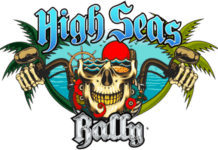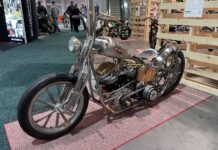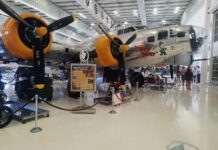Mississauga, Ontario, Canada, Jan. 7–9—I’ve been going to this show for a number of years now and Sunday has always been the day that I attend. So this year I decided to mix it up a bit by trying out the show on a Friday afternoon and evening instead. Maybe there would be a different vibe happening, since folks are getting out of work to start the weekend. Would there be a little more excitement in the air? I was a little surprised at what I found, but more on that later.
Started back in 1976 by Bar Hodgson, the then-owner of the Superbike Center in Scarborough, Ontario, as a way to bring fellow motorcycle retailers together at an event for the public to enjoy, it continues to be the premier motorcycle exhibition in Canada after 35 years. Known as the “big one by the airport,” the Supershow’s physical footprint in the Toronto International Centre is more than 425,000 square feet with seven interconnecting halls, and the show features more than 500 exhibitors. And when I say big, I mean really big. You can find just about anything that has to do with motorcycling all under one roof. Even though each hall has its own theme, there are vendors selling everything from gear to lingerie to sausage scattered throughout all the halls.
Starting at Halls 1 and 2 is where you’ll find all things touring and cruisers. Many of the local riding clubs have displays set up here, some quite elaborate, showcasing their members’ bikes, as well as some of the events and group rides they’ve organized. To name just a few of the clubs, there were the Parry Sound Motorcycle Association, Scarborough Harley Owners Group, Welland County Motorcycle Club and the Zen Riders Motorcycle Club. You could also talk to folks promoting rallies and touring destinations as a way to plan your 2011 riding season.
I think the big story of the show was the Toronto debut of Indian Motorcycles, held in the Industry Showcase in Hall 3. They certainly made a big statement with their prominently placed big rig and all their current models. I was a little curious to see how much the bikes cost since prices are generally higher in Canada, but the tags on the bikes seemed to reflect current U.S. prices. The Indian rep I spoke to confirmed the price tags were, in fact, U.S. dollars since the bikes had just been at a show in Washington, but the Canadian prices wouldn’t be much higher. This latest edition of the Indian Motorcycle Company appears to be continuing its growth and the demand for their bikes in the Greater Toronto area is what prompted the opening of the new dealer (Toronto Indian), and that’s a good sign for the industry. All the other major motorcycle brands were present in Hall 3 as well. Harley-Davidson was very well represented with a large display, and it was good to see many of the Victory Motorcycles models back for the public to view after a year’s absence.
Because I enter the show at the entrance closest to the media desk, Hall 4 (Performance and Racing) is the first one I see. Besides racers, racing associations and gear vendors, there is a full schedule of interviews with motorcycle racers and personalities.
While wandering through “A Century of Motorcycles” in Hall 4A, which has all the vintage and classic motorcycles on display, I happened to notice quite a few (eight to be exact) Vincents. Most of them looked like they were in either original condition or have had some minor restoration work. But among them was one particular 1947 Series B Rapide which was exceptionally restored with pristine paint and polish, almost to the point where it looked too perfect for such an old bike. Unbeknownst to me until after the show, I was looking at the most famous Vincent of all time… Gunga Din.
As luck, or coincidence, would have it, the Canadian pal I went to the show with happened to give me a stack of motorcycle magazines he subscribes to. And in one of the issues was a full write-up about the now-restored Gunga Din! Of course, I didn’t read the article until after the show and that’s when the light bulb in my head finally went off and then I realized what I had just seen in person. Among other vintage and classic bikes were a 1914 Douglas 4 hp flat twin, a 1924 Sunbeam single cylinder, a 1927 Zenith 680cc, and a 1948 James 122cc.
Moving on, Hall 5 is the Chopper and Custom Bike Showcase. The first display that greets you as you enter the hall is Confederate Motorcycles. On hand were the P120 Fighter and the Limited Edition F131 Hellcat Bomber. They certainly have a very exotic look, and the craftsmanship and engineering are top notch, but one of the more memorable custom bikes on display was Glasgow Kiss, by Kootenay Motorcycle Art in British Columbia. Everything on this bike is oversized, from the 1-3/4″ frame tubing to the 280mm front and 300mm rear wheels. Even the springer front end was made from 2-1/2″ tubes. I’ve never seen a custom bike quite like it anywhere. Also in Hall 5 was the EasyRider Saloon, where you can get yourself a $9 beer (ouch!) and kick back and watch the Terez Leathers Fashion Show.
So, did I notice any difference between Friday and Sunday at the show? Well, Friday was actually a little quieter than I expected. When we arrived around 3 p.m., the attendance was modest, but it made for easy navigation throughout the halls without all the bobbing and weaving you normally have to do in a busy crowd. Plus you had first dibs on all the gear and accessories for sale. By the time evening was upon us, it became much more crowded, just like I’m typically used to, but in usual Canadian fashion, people were polite and respectful.
By the time I got around to checking my watch, I realized almost six hours had gone by in the blink of an eye and it was time to head home. On the way out I was able to get a good deal on a tank bag, and some new riding glasses I’ve needed since my favorite pair broke last summer. So on the drive back to Buffalo, sometimes through heavy snow squalls, it felt good to reconnect with the motorcycle world at large; knowing in a few short months I’ll be hitting the road again to start another riding season.





















